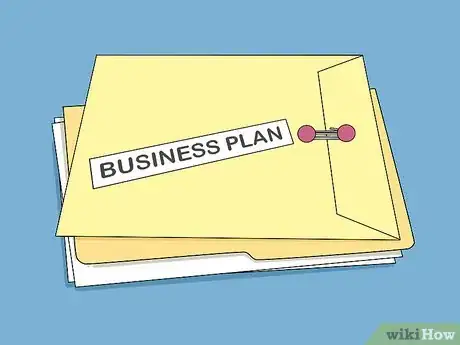This article was co-authored by Michael R. Lewis. Michael R. Lewis is a retired corporate executive, entrepreneur, and investment advisor in Texas. He has over 40 years of experience in business and finance, including as a Vice President for Blue Cross Blue Shield of Texas. He has a BBA in Industrial Management from the University of Texas at Austin.
This article has been viewed 76,056 times.
Strategy can be defined as a plan for reaching a goal, and is focused on transformation as opposed to maintenance. Strategic work surpasses routine upkeep or tactical work, in order to conceive and execute methods for progression and betterment. In order to work on a strategic level, you must move beyond daily responsibilities and incorporate advancement into your priorities. With a little effort and practice, you can figure out how to work strategically on any project.
Steps
Thinking Strategically
-
1Think about the future. Look beyond the immediate and into the future in order to get a clear vision of where you see yourself in the future. Make sure that your plan for the day lines up with your short-term and long-term goals for your company.[1]
- Strategic working doesn’t have to involve outlandish and complex plans. The most important thing to do is to simply connect your thoughts to outcomes in your work.[2]
- Try to schedule regular brainstorming sessions with yourself and your colleagues. Put some ideas down on paper to help capture your thoughts.
-
2Set clear goals. Think about what you want to accomplish in your work in the future, both long-term and short-term. These goals should be specific to your future vision. In addition, they should be measurable and time-specific.
- For example, if you envision enlarging your small, local delivery business, then you may set a specific goal of expanding your delivery area into three more counties, owning a large fleet of delivery trucks, having 200 employees, and/or running a shipping/packing warehouse.
Advertisement -
3Determine strategic actions needed to reach your goals. Gather all of the data you need to determine what it will take to accomplish your goals. Each goal could have numerous strategies that will achieve the goal but with different costs, schedules, and resources. You should consider strategic elements like what materials you will need and how much time you think it will take to achieve these goals.
- For example, if your goal involves expanding your delivery business, you should consider how much it will cost to purchase more delivery vehicles, how you might increase your marketing to expand into new areas, and how much time/money it will take to do accomplish these things.
-
4Prioritize your goals. Write each goal out, including the method(s) you will use toward accomplishment, costs, resource requirements, delegation of responsibilities, and the time it will take to achieve the goal.[3]
- Consider which goals you will need to address first – which are more important, or which might need to be accomplished before others can be tackled.
- Consider immediacy, importance, and ease of execution. Some goals may be very important to your future vision, but may not be immediate, as they will take the most time and money to execute – while other goals may be less vital, but immediately and easily executable.
- For example, if you want to expand your delivery business, it might benefit you to start slowly expanding your marketing outreach in small, easily-achievable ways (like by distributing fliers) before you start acquiring additional delivery vehicles. It’s true that you’ll need more delivery vehicles if your market expands, but purchasing cars is a big investment to make before the need is confirmed.
-
5Take time to reflect. Each day, try to take a few moments to reflect on what you’ve accomplished and how your accomplishments align with your goals, even if it is just for a few minutes. In today’s fast-paced world, people often forget to stop and think about what they’ve learned because they’re too busy moving on to the next step.[4]
- Think about your work each day and what you learned from it.
Creating a Strategic Plan
-
1Consider all variables. The base word in strategic thinking (or working) is “strategy.” This means that when you are creating your plan, you need to carefully consider all variables that could possibly affect your work.
- Think about things like outside disturbances, financial setbacks, unexpected costs, etc.
- For the delivery truck example, you would need to consider the price of gasoline for the additional vehicles, the cost of insurance for the new drivers, what might happen if there is an accident in one of the delivery vehicles, the cost of additional advertising in the new market, etc.
-
2Create a plan. Once you identify, organize, and prioritize your goals, outline the strategic work steps you will take towards those goals in chronological format. Following a carefully constructed order of operations is necessary to working strategically. For each of your goals, you need to define a series of actionable steps that will lead to achieving that goal, taking all of the information you gathered into account. Create a plan in the following way:
- For example, if you want to expand your delivery service by purchasing new vehicles, you will need to craft a strategy to come up with the extra capital needed to purchase them and increase your number of employees.
-
3Put your plan on paper. Write your plan down so that there is a physical record and you can easily keep track of where you’re at in your plan at all moments. You may do this by hand, or you may implement any of a number of computer-based planning/time-management applications.[5]
Implementing Your Plan
-
1Put your plan into action. Keeping your goals in mind and being conscientious of time constraints, follow the steps you outlined in your plan. Stick to your plan and try not to deviate without careful consideration. You spent a lot of time thinking about your goals and the future of your work, so remain confident in your plan.
- Communicate your plan with your colleagues. Communication is crucial for any successful business strategy. Make sure your fellow coworkers are aware of your plans and goals so that they can be working with these things in mind as well.[6]
- If possible, try to involve your colleagues in the planning stage so that they feel more engaged and personally invested in your company’s goals.
-
2Evaluate your progress. Strategic work involves setting priorities so as to most efficiently accomplish tasks. Those priorities may shift regularly, due to a number of outside circumstances, and you need to be able to identify the shift so as to reallocate your resources accordingly. Consider the plan you originally laid out and how well you are meeting those goals.
- If you find that you are not meeting your goals as well as you feel like you should, be open to the idea of tailoring your plan to whatever your current situation is.
-
3Make necessary adjustments. Determine if your goals are realistic to the time frame you have outlined. You may find that your plan is not resulting in timely results, or that you are accomplishing steps faster than you had expected. Either way, you should reframe your goals and/or plan so they are in line with reality.
- For example, if you unexpectedly find a fleet of trucks at a record-low clearance price, then it may be a good idea to make that purchase before investing in the previously high-priority piece of business property that will most likely stay on the market.
References
- ↑ https://hbr.org/2014/01/strengthen-your-strategic-thinking-muscles/
- ↑ http://www.e-myth.com/cs/user/print/post/strategic-work-made-simple
- ↑ http://www.e-myth.com/cs/user/print/post/strategic-work-one-step-at-a-time
- ↑ http://www.inc.com/lauren-perkins/three-essential-steps-to-thinking-strategically.html
- ↑ http://www.e-myth.com/cs/user/print/post/strategic-work-one-step-at-a-time
- ↑ http://www.mckinsey.com/business-functions/strategy-and-corporate-finance/our-insights/becoming-more-strategic-three-tips-for-any-executive







































































